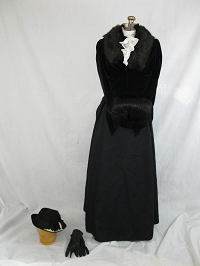1890s
The color of mourning in the 1890s was black. A widow spent two years mourning a husband. During the first year, only black wool trimmed in black crepe was allowed. During the second year, black silk and lace were common. For the last six months of the two-year mourning period, a woman was permitted to wear gray, violet, or white trim on her clothing.
The mourning period lasted for six months for the death of a brother, sister, or child. The death of a friend or acquaintance was mourned for six months, but only if they left you an inheritance.
Men wore a black arm band to indicate mourning, but had no other changes to their everyday clothing.
This graceful winter suit would have been appropriate attire to go out for an evening. The skirt is flat in the front with pleats on each side and pleated in the back. The coat bodice has nine deep points. A bouffant pouf of velvet is set under the middle point in the back and terminates in two long points which fall low on the skirt. The sleeves are cut with a small puff at the top which was stylish in 1890. Although suits with separate blouses became popular at this time, we constructed this one with only a chemisette (or dickey) that fills in the neck and down the front. There are also frills around the sleeve edge. A round hat of black felt trimmed in ostrich plumes and flowers top the upswept hair style. A fur muff and kid gloves complete the outfit. Even her petticoat is black. It's of taffeta and has embroidered spots and a border.
Click on the image for detailed views.


